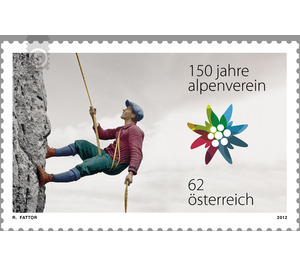150 years - Austria / II. Republic of Austria 2012 - 62 Euro Cent
Theme: Sports & Games
| Country | Austria / II. Republic of Austria |
| Issue Date | 2012 |
| Face Value | 62.00 |
| Edition Issued | 300,000 |
| Printing Type | offset |
| Stamp Type | Commemorative |
| Item Type | Stamp |
| Chronological Issue Number | 2310 |
| Chronological Chapter | OOS-OE2 |
| SID | 696960 |
| In 55 Wishlists | |
The purpose of the association was "to spread the knowledge of the Alps, to promote love for them and to facilitate their journey". As a means to lectures and publications served. However, in the eyes of many members, the scientific self-understanding and the centralist organization did not adequately fulfill the purpose of the association. On the contrary, they wanted practical activities, such as those of the former Ötztal parish curate, a certain Franz Senn, realized even then. Senn envisioned a partnership of recreation-seeking city dwellers and mountain dwellers. Paths and lodges, trained mountain guides and maps and guides should serve. After turbulent and turbulent years in the first half of the 20th century, when politically unclean decisions were often made within the association, after the end of the Second World War, a difficult path to clarify the legal situation of the Alpine Club began. The continued existence had to be enforced before the Constitutional Court. The sections were partially recognized in their existence, in some cases they had to re-form. In 1951, the Alpine Club finally adopted the old name "Austrian Alpine Club". With the normalization of living conditions and the economic upturn, the activities and membership of the association increased again significantly. People were again paying more attention to vacation and leisure. In the 1980s, several new developments began. The environmental movement led to an appreciation of nature conservation in the Alpine Club. He was the largest landowner to enforce the realization of the Hohe Tauern National Park, the youth were for the first time offered environmental construction sites, and the consistent training of section functionaries had positive effects. At the same time, the sporting events on the mountain became increasingly colorful, new sporting trends emerged. Most important for the Alpine Club was the development of sport climbing on natural rocks and art walls. Since the early 1990s, the number of members also increased rapidly due to new services. Of course, the broad enthusiasm for health-conscious physical activity in nature also strengthened the importance of huts and paths. Today, OeAV is the largest alpine club that sees itself as representing the interests of all mountaineers in Austria. His most important tasks are the promotion and practice of alpine activities such as hiking, mountaineering, climbing, ski touring and many trend sports in the mountains and the necessary training of professionals. 22,000 volunteer employees are committed to providing a diverse range of services.


